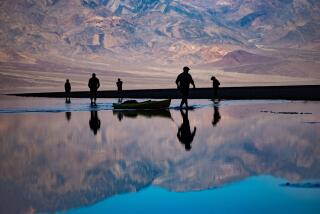Mt. Rainier Water Flow Tied to Meteorology, Not Geology
- Share via
The release of accumulated glacial water on Mt. Rainier late Tuesday resulted in a rise of the Nisqually River in Washington state--and the sounding of a brief geological alarm.
Mt. Rainier National Park rangers closed the highway to Paradise, the park’s main visitor center, for several hours after a small flow of mud and debris dislodged some trees and rocks. The water level on the Nisqually rose about 2 feet at the highest point.
But when geologists from the Cascades Volcano Observatory inspected the area Wednesday, they were able to attribute the glacial release to the hot weather, discounting initial speculation that a potentially more serious “glacial outburst” had occurred.
An outburst would have involved the overflow of accumulated water from underneath a glacier, triggering possibly damaging flooding of the Nisqually River in populated areas.
But Ed Klimasauskas, a geologist at the volcanic observatory in Vancouver, Wash., said this turned out to be a transitory event directly related to the weather.
Furthermore, there were no earthquakes that might have presaged volcanic activity.
Scientists pay close attention to the glaciers and slopes of Mt. Rainier. There is evidence that, in past centuries, there have been catastrophic mudflows from Rainier that flooded parts of what is now the Tacoma metropolitan area.
The event that began Tuesday about 9 p.m. triggered concern that such a mudflow was beginning. But the river never rose enough to trigger an evacuation warning downstream.
The water receded to more normal levels by 5 a.m. Wednesday, and the Paradise highway was reopened. But Klimasauskas said that geologists believe there could be slight rises in the water level in the next few days.
Mt. Rainier, at 14,410 feet, is the largest volcano in the contiguous United States. It last erupted in a small way in the 1840s.
More to Read
Sign up for Essential California
The most important California stories and recommendations in your inbox every morning.
You may occasionally receive promotional content from the Los Angeles Times.










